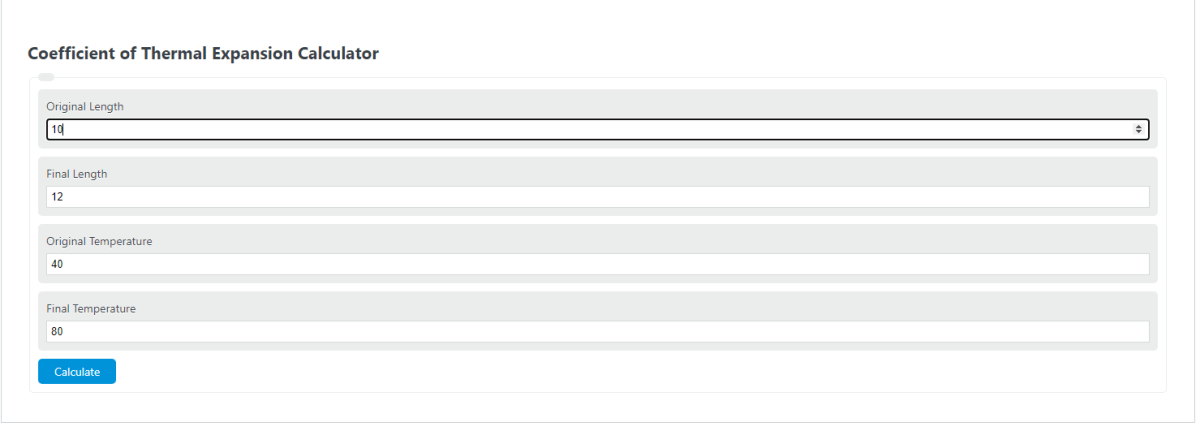Enter the original length, the length after a change in temperature, the original temperature, and the final temperature to determine the coefficiency of thermal expansion.
- Thermal Expansion Calculator
- Heat Shrink Size Calculator
- Thermal Conductivity Calculator (heat flux)
CTE Formula
The following formula is used to calculate the coefficiency of thermal expansion.
a = (L2-L1)/(T2-T1)
- Where a is the coefficient of thermal expansion (CTE)
- L2 is the final length of the object after a temperature change
- L1 is the initial length of the object before the temperature change
- T2 is the final temperature
- T1 is the initial temperature
It’s important to note that this formula solves for a linear coefficient of thermal expansion. This means it can only be applied to the object in linear terms.
CTE Definition
What is a coefficient of thermal expansion?
The coefficient of thermal expansion is a numerical value that quantifies how much a material expands or contracts when its temperature changes. It represents the fractional change in length, area, or volume of a material per unit change in temperature.
Example Problem
How to calculate a coefficient of thermal expansion (CTE)?
The following example problem outlines the steps necessary to calculate the linear coefficient of thermal expansion.
First, measure the original length of the material and take the initial temperature. For this example, the original length is 10 inches and the initial temperature is 40 degrees Fahrenheit.
Next, subject the material to a temperature change and measure the final length of the object after it fully reaches the final temperature. For this example problem, the final length is measured to be 12 inches and the final temperature is 80 F.
Finally, calculate the coefficient of thermal expansion using the formula above:
a = (L2-L1)/(T2-T1)
a = (12-10)/(80-40)
a = .05 inches per degrees F
FAQ
What materials have a high coefficient of thermal expansion?
Materials with a high coefficient of thermal expansion include plastics, aluminum, and glass. These materials expand more significantly with temperature changes compared to materials like steel or concrete, which have lower coefficients.
How does the coefficient of thermal expansion affect engineering designs?
The coefficient of thermal expansion is crucial in engineering designs as it helps predict how different materials will expand or contract with temperature changes. This understanding is essential for ensuring that structures and components can withstand temperature variations without failing.
Can the coefficient of thermal expansion be negative?
Yes, some materials exhibit a negative coefficient of thermal expansion (NCTE), meaning they contract when heated and expand when cooled, which is opposite to the typical behavior. This rare property is found in certain materials like silicon carbide and zirconium tungstate.
Is the coefficient of thermal expansion constant for all temperatures?
No, the coefficient of thermal expansion can vary with temperature. For many materials, the coefficient increases as temperature increases. However, this relationship can be complex and depends on the material’s specific thermal and structural properties.
